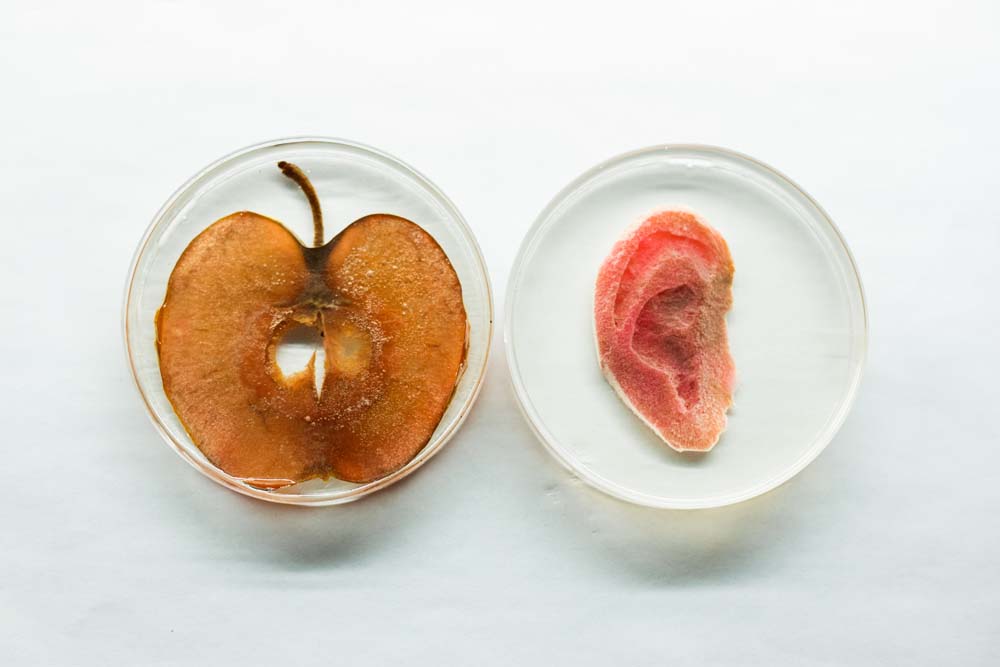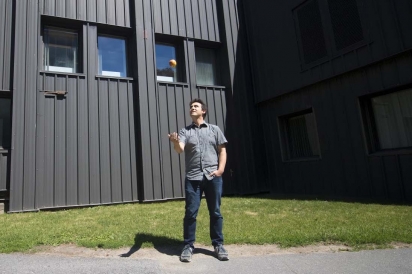The Apple Experiment
There are days, says Andrew Pelling, when he feels more like a vendor at a farmers’ market.
“There’s produce all over the place,” says the 37-year-old biochemist, whose workspace is actually one of the more innovative, experimental and just plain strange laboratories at the University of Ottawa — and recently ground zero for an unexpected discovery that could make growing human tissue almost as cheap as buying an apple.
Since 2008, the U.K.-born, Toronto-raised Pelling has run the eponymous Pelling Lab for Biophysical Manipulation. It’s a place where childlike curiosity drives most of the research: once, the lab tried to grow Audrey II, the carnivorous plant from the cult classic Little Shop of Horrors. Another time, they tried to see if mammalian cells would grow at different speeds if they rocked out to Metallica. Neither worked — Pelling says they go into their experiments expecting them to fail, while hoping they won’t.
The apple experiment, however, has been a sweet exception.
It was about three years ago that one of his lab mates came up with the idea of using an apple as the raw material for a tissue scaffold: a synthetic structure used in medicine as the meshwork, essentially, on which human tissue, such as bone or cartilage, is grown or regrown. (They’re commonly used, for example, in bone grafts.)
A major problem with traditional scaffolds is that they’re startlingly expensive. So armed with strong detergent, Pelling’s team set out to see if they could create a scaffold using nothing more than a generic McIntosh apple. They peeled it and scrubbed away all the things that make it an apple — for non-scientists, at least — stripping it of its DNA and apple cells until they were left with a simple cellulose core. Pelling’s wife, a violin maker, carved that cellulose into the shape of a human ear and the lab added living human muscle cells and enough nutrients for them to divide.
Then, they waited... for a few months. Eventually, they ended up with something resembling a human ear.
“It wasn’t supposed to work. This was a crazy idea from the start,” Pelling says, laughing. “But we tried it. And that’s what my lab really does for a living. Most times things don’t work and they fail; this time, it happened to work.”
To be clear, it’s not the fact the cells divided on the cellulose scaffold that makes what Pelling’s lab accomplished so noteworthy. It’s that they were able to create a scaffold out of something that sells for a few dollars a kilogram — a breakthrough that could drastically reduce the costs associated with generating human tissue.
“We’re not doing anything new or different here. There’s a lot of money being spent on scaffolds that are synthetic. Some are made out of synthetic polymers, or they’re derived from cadavers,” says Pelling. “But this costs pennies.”
In the same way apples aren’t the only fruit at the farmers' market, they’re not the only foodstuffs with which Pelling, also a Canada Research Chair in cell mechanics, and his team have been messing around. They’re trying to do similar things with mushrooms and tofu — each one has different textures, which could lead to different scientific applications — as well as an “applesauce” scaffold, which could conceivably be injected into difficult-to-get-at areas of the human body, such as a wound inside a bone.
Then, there are the experiments with asparagus. Pelling thinks the fibrous cellulose structure of asparagus could potentially have applications for treating damaged spinal cords and nervous systems. This was, he notes, something he realized while chopping up a few stalks up in his kitchen.
Yet, for all of the practical possibilities his research offers, Pelling says he’s most entranced by the “pure investigation” that his lab allows to flourish, the unexplored corridors of knowledge that asking unorthodox or outright bizarre questions might lead them down. He’s particularly intrigued these days by the idea that cheap DIY fruit and vegetable scaffolds could be one day used in the obscure, but increasingly popular, world of body modification.
“The medical aspects are a bit more obvious to me, and of course, we’re exploring them seriously, working with doctors and clinicians to do that work,” says Pelling. (His team recently had a paper on implanting his apple-grown scaffolds in mice accepted by the peer-reviewed online journal Plos One. While human trials are a long way off, Pelling points out that none of the mice experienced any long-lasting signs of rejection.)
“But the less obvious and more curious question is, you know, can I implant flower petals in my skin? Create textures in my own skin, modify my body with these natural materials?” he adds. “People are already implanting electronics under their skin, circuit boards, God knows what.”
For now, Pelling is continuing to carry out curious experiments — one they’re not giving up, he says, involves hooking a pork chop up on the internet, growing new cells on it, and having the piece of meat report resulting changes in electrical resistance on Twitter. And he says he has no plans to stop fostering that sense of childlike wonder that makes his lab such an outlier in the academic world.
“We just lose that, somehow, on the path to adulthood,” says Pelling. “And this maybe wasn’t intentional from the start, but I just started saying, ‘Yeah, it’s okay for me to ask crazy questions.’ And I just kept doing it. And now, I’ve just gotten really good at it — so that’s what we do.”






